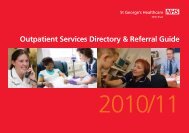pathology services handbook - St George's Healthcare NHS Trust
pathology services handbook - St George's Healthcare NHS Trust
pathology services handbook - St George's Healthcare NHS Trust
Create successful ePaper yourself
Turn your PDF publications into a flip-book with our unique Google optimized e-Paper software.
3.4 OUT OF HOURS ADVICE AND REQUESTS<br />
The on-call mortuary technician can be contacted ‘out of hours’ on Pager SG240.<br />
There is no ‘out of hours’ service for Histo<strong>pathology</strong> or Cyto<strong>pathology</strong>.<br />
3.5 HISTOPATHOLOGY<br />
LOCATION - <strong>St</strong>. George’s Hospital, Basement - Jenner Wing Cellular Pathology, Histology<br />
Section.<br />
3.5.1 SUBMISSION OF HISTOPATHOLOGY SPECIMENS<br />
If an URGENT report is required please state this on the request form. Always provide a<br />
contact or bleep number. Hand -deliver urgent specimens to Cellular Pathology.<br />
Most specimens should be submitted in adequate 10% neutral buffered formalin - sufficient<br />
to fully cover the specimen with the exception of the samples listed below:<br />
Exceptions - which should be immediately hand delivered fresh via theatre staff.<br />
These specimens should be booked with the laboratory as outlined in section 3.5.6<br />
• Frozen section specimens - send fresh immediately in a dry pot.<br />
• Lymph nodes - send fresh immediately in a dry pot.<br />
• Muscle biopsies - send fresh immediately in a dry pot (unless being sent from an outside<br />
hospital in which case they should be sent immediately wrapped in lightly dampened saline<br />
gauze).<br />
• Nerve biopsies - send fresh immediately; on a swab slightly moistened saline in a dry pot.<br />
• Paediatric GI biopsies for Hirschprung’s disease – send fresh immediately; on a swab<br />
slightly moistened saline in a dry pot.<br />
• Renal biopsies - send fresh immediately; on a swab slightly moistened saline in a dry pot.<br />
• Skin biopsies for immunofluorescence - send fresh immediately; on a saline moistened<br />
swab in a dry pot.<br />
3.5.2 REQUEST CARD<br />
Each set of specimens from an individual patient must be accompanied by a fully<br />
completed Histo<strong>pathology</strong> request card including a bleep or contact number.<br />
3.5.3 PROCEDURE FOR HIGH RISK SPECIMENS:<br />
High-risk specimens are those that could, potentially contain category 3 or 4 pathogens<br />
(i.e. Hepatitis B or C, HIV etc). For a comprehensive list of micro-organism refer to the<br />
Advisory Committee on Dangerous Pathogens (ACDP).<br />
All high risk specimens must be clearly labelled with a yellow biohazard label on<br />
both the specimen and request form.<br />
3.5.4 SPECIMEN PROBLEMS:<br />
Unlabelled / Unidentifiable specimens will not be processed.<br />
Samples pots must be securely fastened prior to transportation.<br />
Leaking specimens may result in poor sample processing.<br />
3.5.5 ROUTINE HISTOPATHOLOGY REPORTS<br />
Histopathological processing and reporting of small biopsies takes 1-3 days. Larger<br />
specimens can be processed and reported within 5 days, but may take longer if further<br />
Pathology Services Handbook v3.2.2 - February 2013 15 of 81





